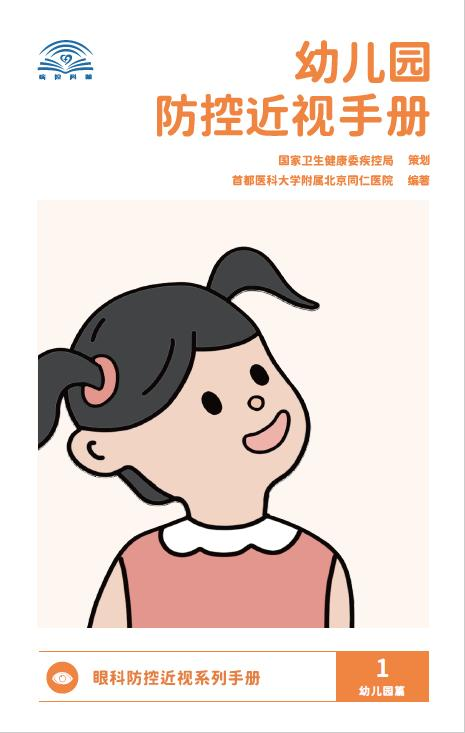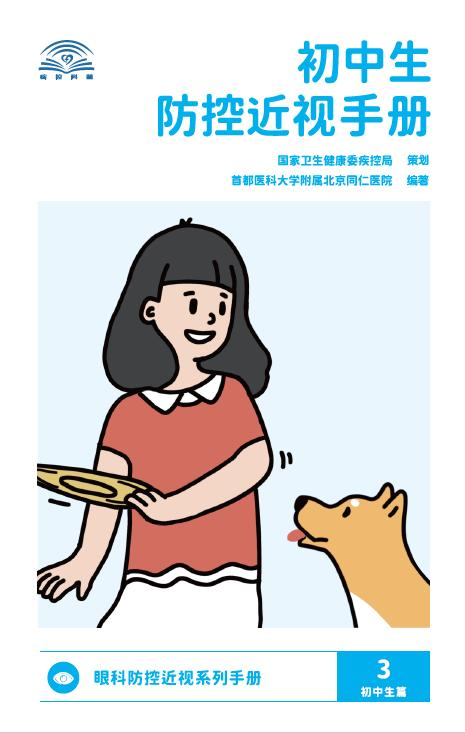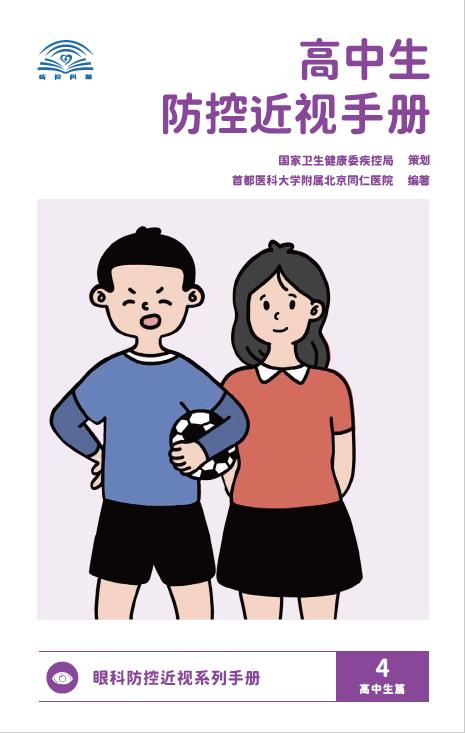On October 27, 2020, the National Health Commission's Center for Disease Control and Prevention released the "Handbook Series for the Prevention and Control of Myopia in Children and Adolescents". This set of handbooks was planned by the National Health Commission's Center for Disease Control and Prevention and compiled by Beijing Tongren Hospital affiliated to Capital Medical University. It is divided into kindergarten, primary school, junior high school, and high school editions, and based on the characteristics of different age groups of adolescents, it guides parents and children to protect their eye health together. The PDF version of the handbook can be downloaded by logging onto the official website of the National Health Commission.
The problem of myopia in children and adolescents in China has always been widely concerned by society. In recent years, it has shown a trend of high incidence and low age, seriously affecting the physical and mental health of children. The central government and the State Council attach great importance to the prevention and control of myopia in children and adolescents. General Secretary Xi Jinping has made important instructions on the issue of visual health of children and adolescents from the perspective of the future of the country and the nation. The National Health Commission has always regarded the prevention and control of myopia in children and adolescents as a top priority, strengthened its responsibility, fulfilled its duties, and resolutely fought against the prevention and control of myopia. Over the past two years, through joint efforts, positive progress has been made in the prevention and control of myopia in children and adolescents.
Since the outbreak of COVID-19, many reasons, such as reduced outdoor activities, increased use of electronic products, and increased visual load at close range due to home study and life of children and adolescents, have increased the risk of myopia in children and adolescents, and brought new challenges to their eye health and myopia prevention and control work.
In order to implement the important instructions of General Secretary Xi Jinping on the issue of myopia in children and adolescents, promote the "four-party responsibility" for myopia prevention and control by the government, schools, families, and society, and strive for practical and effective results, so that every child and adolescent can become the master of their own health, the Chinese Center for Disease Control and Prevention (CDC) of the National Health Commission organized and planned a series of manuals for myopia prevention and control in children and adolescents, commissioned by Professor Wang Ningli and Professor Li Shiming of Beijing Tongren Hospital Affiliated to Capital Medical University to compile the manuals, including kindergarten, primary school, junior high school, and high school. The manuals start from the characteristics of students at different ages and other situations, and transform ophthalmology professional knowledge into popular science knowledge and skills, guiding personnel engaged in children and adolescents' health work to do a good job in myopia prevention and control, further promoting the whole society to take action, and jointly taking care of the eyes of children.
(I) Handbook for Preschool Children on Preventing and Controlling Myopia: How to Prevent and Control Myopia in Children and Adolescents Aged 3-18

To determine whether a child's vision is normal, age should be taken into consideration, and the following standards can be used as reference: vision can reach 0.4 at 2-3 years old, 0.5-0.7 at 3-4 years old, 0.8-1.0 at 4-5 years old, and 1.0 or higher for children over 6 years old.
Common early symptoms of myopia to be aware of include: blurred vision when looking at distant objects (such as not being able to see words on the blackboard or complaining about the lighting being too dim), squinting often when looking at distant objects, holding reading materials too close, frequent blinking, frequent frowning, tilting the head to look at objects, and having crossed eyes while looking at things.
Normal newborns should have a refractive screening at 6 months of age. If the refractive state is normal, regular check-ups should be done every 6-12 months. Preterm infants and low-birth-weight infants should undergo retinopathy of prematurity screening as required and be followed up regularly. At around 3 years old, children should learn to recognize the visual acuity chart with their parents and have their vision and refractive error checked every 6-12 months.
Newborns' eyes are in a hyperopic state, known as "hyperopia reserve". Prolonged close-range eye use can lead to premature depletion of children's "hyperopia reserve" and ultimately result in myopia and other issues. Therefore, children are not encouraged to use electronic devices at an early age.
Outdoor activities can effectively prevent the onset and development of myopia, and children should sleep for at least 10 hours a day and eat foods that are beneficial to visual health, such as fish, fruits, and green vegetables.
(II) Handbook for Preventing and Controlling Myopia Among Elementary School Students: Don't Read or Write Continuously for More Than 30-40 Minutes.

During elementary school years, it is a high-risk period for myopia. Parents should take their children to regular medical institutions for vision check-ups every 6-12 months. It is recommended to conduct dilated refraction and measure the axial length of the eyes.
If myopic children do not wear glasses for a long time, their retinas will remain blurry, which can lead to eye fatigue and possible further increase in myopia. If the difference in the degree of myopia between the two eyes is large and the child does not wear glasses, it may suppress the weaker eye's vision and affect binocular vision, leading to amblyopia.
A study found that children who persist in doing standardized eye exercises have slower myopia progression than those who do not or do non-standardized eye exercises.
The use of electronic devices for non-learning purposes should not exceed 15 minutes per session, and the total daily usage time should not exceed 1 hour. Continuous reading and writing time should not exceed 30-40 minutes. If using electronic devices for learning, take a break and look into the distance for 10 minutes after 30-40 minutes of use. At home, hot compress with a towel can promote blood circulation around the eyes.
Elementary school students need at least 10 hours of sleep per day.
(III)Manual for preventing and controlling myopia in junior high school students: Learn to cover one eye alternately to self-check visual acuity.

It is recommended that junior high school students, whether myopic or not, have their vision checked every 6-12 months at a regular medical institution, and undergo an optometry examination.
Less than 300 degrees of myopia is considered as low myopia, 300-600 degrees is considered as high myopia, and more than 600 degrees is considered as highly myopic. Individuals with highly myopic or pathological myopia should avoid strenuous activities, vibrations, and external impact on the eyeballs to prevent eye diseases such as retinal detachment or tear. They should also avoid sudden impact head movements such as diving, weightlifting, and roller coaster rides as much as possible.
Junior high school students should learn to pay attention to their own vision and can self-check their vision by alternately covering their eyes. If there is a significant change in the vision of one or both eyes, they should go to the eye hospital for a check-up as soon as possible.
They should conscientiously and regularly do eye exercises, correctly press acupoints until they feel a sense of soreness. They should maintain a balanced and nutritious diet and control the intake of sweets and fried foods, and limit the consumption of carbonated drinks. They should ensure sufficient sleep, with 9 hours of sleep per day for junior high school students.
(IV) Manual for High School Students to Prevent and Control Myopia: Don't Rely Blindly on Laser Myopia Surgery.

High school students are advised to have their vision checked every 6-12 months, and those who wear glasses should have a dilated eye exam about once every 12 months. During this age period, students face increased academic pressure, engage in extensive near-distance reading and have reduced outdoor activities, making them a "high-risk area" for myopia development.
Students and parents should understand that corneal laser myopia surgery does not cure myopia. It simply uses a laser beam precisely controlled by a computer to reshape the cornea, creating a corrected "lens" on the patient's own cornea so that light can be accurately focused on the retina. After surgery, students should reduce their near-distance eye use for 1-2 months.
As minors age, their degree of myopia may still increase to varying degrees. Therefore, if myopia surgery is performed at this stage, although it corrects myopia, the eye axis will further elongate due to the unstable degree of myopia, which may cause visual acuity to decline again.
Source: National Health Commission of the People's Republic of China official website and Health Times Press.

【Scan and follow us】